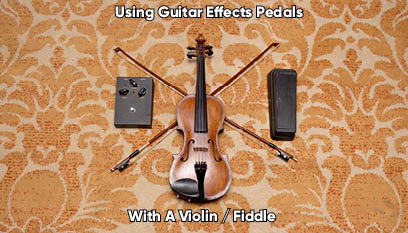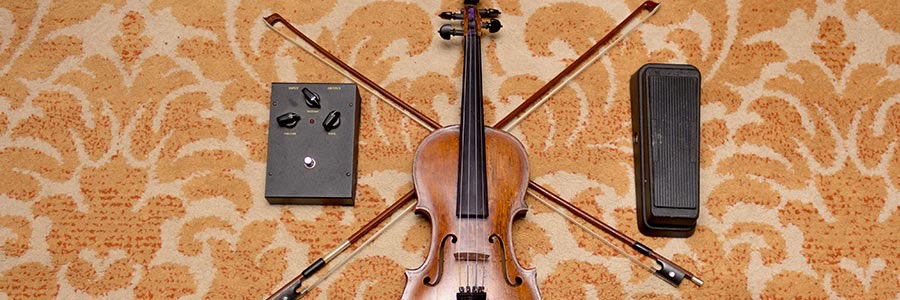
If it has an electric signal, you can put effects on it. It’s really that simple. For real-world inspiration on adding effects to fiddle we met up with fiddle player Connor Vance of the Dustbowl Revival a genre-defying band where Connor’s effected fiddle provides everything from textures to solos.
A violin-playing music major once told me that the difference between a violin and a fiddle is “whether you play fiddle music on it.” So violins and fiddles are the same thing. Beyond that, I don’t know anything about them. But when I saw Connor Vance use an epic pedal board with his fiddle, I knew I had to learn more.
Connor plays fiddle for The Dustbowl Revival. If you’re unfamiliar with them, you should check them out! Based out of Los Angeles, California, The Dustbowl Revival is an eight-piece band whose sound is hard to peg to a specific genre. Overall, the band mixes elements of Americana and New Orleans jazz, but on tracks like “Call My Name” (the opening track of their 2017 self-titled release) the funk influence is undeniable, and “Busted” sounds almost like a break-up empowerment pop tune.
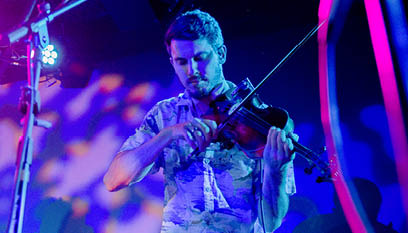
Pedals to Serve the Tunes
When I first encountered The Dustbowl Revival, I was working behind the bar at a house concert in Exeter, New Hampshire. I had recently returned from a whirlwind trip to Hawaii with my wife and I was still trying to figure out what day my body thought it was. The jetlag added to the disorientation I experienced when this wall of sound hit me. The Dustbowl Revival is hard to describe, but it’s definitely impressive.
At a break I approached the fiddler (Connor) and remarked that I’d seen a lot of pedal boards in my day, but they were all used by guitarists, bass players, or keyboard players — I’d never seen a fiddle player with one before. We were able to meet up a few months later when their tour schedule routed them back through New England, and we had a chance to really dive into his setup.

This pedal board is HUGE. I wasn’t sure if it was set up for flash or utility. Many of us (OK, most of us) are guilty of keeping a pedal or four on the board for making noise rather than for playing actual songs.
[Content note, when we provide links to Connor’s pedals they are all links to Amazon – unless it is a product that is not sold on Amazon.]
Connor said that his pedal rig was built to meet the needs of the band. For example, he got the Leslie pedal to help provide “some atmospheric, washy pads.” The wah/wah (Connor uses a Fulltone Clyde Wah) helped fill in rhythm.
After a while the wah alone wasn’t filling the void in the band, so Connor added in the octave pedal. That choice confused me, because I wasn’t sure what there was to gain by taking a violin/fiddle down a step (or more). Connor explained that there’s already a lot of higher register instruments in The Dustbowl Revival (mandolin & trumpet), so using the octave, especially with other effects, allows him to move into a tonal range that fills out songs better.
Adding in the Fulltone Fulldrive for a bit of dirt, and using his amp simulator to add some warmth to the tone, helps the rhythm guitar style parts he’s playing to cut through in a natural way.
While the wah, octave and Fulldrive are pedals that you’d see on any guitar player’s board. He also has a T.C. Electronic Hall of Fame reverb and a MXR Bass Compressor, which are pretty common pedals for guitarists. Adding a little bit of reverb and cutting some of the spikes out of the chain are just as handy for a fiddler as they are for a guitarist.
Connor also has some specialized weapons that allow him to transform his fiddle in exciting ways.
The Electro-Harmonix Lester G Leslie rotary speaker simulator allows him to convincingly move into the space that an organist or pedal steel guitarist would occupy. When he uses this pedal, he loves to watch the sound engineer (and the audience) frantically look around for the organist, and eventually realize that the sound is coming the fiddle.
When the Fulldrive doesn’t provide enough bite, Connor has the Fuzzrocious M.O.T.H. pedal ready to go. Add the amp simulator, octave pedal, and wah pedal, and he’s able to create riffs that wouldn’t sound out of place on a Rage Against The Machine album. The M.O.T.H. (Multi Overdrive Tremolo Hex) also includes a built-in sine wave generator that gives him the ability to get down and “play the board” like many noise guitarists do.
When asked what pedal he had his eye on next, Connor wasn’t sure. His process for adding to his board is lengthy, because he wants to make sure the pedal will serve the band. “Every pedal I’ve gotten took me six months laboring over the decision,” he said. “Because it’s always… ‘Is it too tacky? It it going to sound tacky? Is it a gimmick or do I actually want to use it for something that sounds good in the band?’”
Pedals for Violins/ Fiddles
I kept expecting Connor to bust out an electric violin, similar to what I’ve seen Boyd Tinsley (formerly of the Dave Matthew Band) or Andy Happel (of New England 90s legends Thanks To Gravity) play. While Connor has played electric violins in the past, he prefers to use a traditional fiddle with a piezo pickup. That way, he can still play acoustic when he needs to.
One pedal is absolutely crucial to Connor’s ability to cover so much sonic ground: his Audio Sprockets ToneDexter. This pedal allows him to easily switch between a direct-input style signal and a variety of simulated microphones — including microphones he can program in himself. In Connor’s opinion, “the Tone Dexter is really one of the best pedal inventions for string players. It takes your piezo and makes it sound like a mic. The Fishman Aura does a similar thing, but [the ToneDexter] allows you to make your own presets.”
Check out the video below to see Connor demonstrate these effects:
Other String Players Doing Interesting Things With (and Without) Effects
Andrew Bird was classically trained as a child in the Suzuki method before becoming a pioneer in the world of violin-led indie rock. He is known for incorporating less common playing styles like the strumming and plucking of the pizzicato style and for using looping and pitch-shifting effects.
Jean-Luc Ponty is credited as being the violin pioneer who finally found the instrument a place in modern jazz. Ponty’s violin style was highly influenced by the saxophone styles of Miles Davis and John Coltrane. A musician’s musician, he worked with Elton John on the Honky Chateau record before emigrating to the United States at the urging of Frank Zappa and the Mothers of Invention to join their tour. He has also worked with famed jazz musicians such as Chick Corea and also John McLaughlin’s Mahavishnu Orchestra.
Ed Alleyne-Johnson is, strangely enough, best known as a busking artist. He has been busking since he was an art student in the early 1980s at Oxford University. He uses a custom-made pedal board and amplifier that has been modified to run on rechargeable batteries. This highly adaptable rig has enabled him to perform his unique looping and effected music in almost every major city in Europe, the United States, and Canada.
Owen Pallett is also known as Final Fantasy. He arranged strings for Arcade Fire’s albums Funeral and Neon Bible. His own music spans the genres from indie pop to classical, to Baroque pop, to art rock and experimental music.
Lindsey Sterling is a violinist, composer, dancer and performance artist. She is best known for her choreographed violin performances on her YouTube channel. These performances feature violin mixed with dubstep and electronic influences with surprisingly high production value.
2 Cellos. OK, they’re not playing violins, but I feel like I can’t mention Lindsey Sterling’s stellar YouTube Channel and leave out 2 Cellos and their re-imagined modern covers.
A Few Famous Rock Tunes Featuring Violins or String Sections
https://youtu.be/tnepPZChA5U?t=30
The Devil Went Down to Georgia | Charlie Daniels’ Band | Charlie Daniels
This 1979 classic features a traditional blues archetype (making a deal with the devil), and has become a “must perform” song for any fiddler who aspires to stardom.
Baba O’Riley | The Who | Dave Arbus
The leading track off The Who’s classic, Who’s Next, is best known for two elements: the circular synthesizer riff programmed by songwriter Pete Townshend and the featured violin solo offered by Dave Arbus.
Hurricane | Bob Dylan | Scarlet Rivera
Scarlet Rivera plays a compelling melody and series of fills throughout most of this classic Dylan song, which is the lead track of Desire. The song tells the (mostly) true story of the wrongful imprisonment of boxer Rubin “Hurricane” Carter. Rivera’s melody becomes more and more dissonant as the story grows darker. Without her parts, this 8+ minute opus would likely not be the cultural touchstone that it is.
3 Libras | A Perfect Circle | Paz Lenchantin
One of the biggest songs from the early 2000s alternative rock act A Perfect Circle, “3 Libras” is centered around the interplay of vocals, acoustic guitar, and violin. It hit number 12 on both the Billboard U.S. Mainstream and Modern Rock charts.
Wish You Were Here | Pink Floyd | Stéphane Grappelli
While Stéphane Grappelli did in fact play on this song during its original recording, his performance was almost entirely removed from the final mix. The official release doesn’t feature any of his playing except during the very long outro (there’s a slight screech of strings around the 5:20 mark). It is only due to remixed releases of the song that include most of Grappelli’s performance, beginning in the instrumental break before the second verse, that this song makes the cut for this list.
Kashmir | Led Zeppelin | Studio Musicians
Featuring one of the best-known “string riffs” in hard rock, this song was inspired by singer Robert Plant’s trip to Morocco, as well as guitarist Page’s fondness for Eastern and Arabic music.
Come On Eileen | Dexy’s Midnight Runners | Helen O’Hara
This English hit featured the Celtic- inspired fiddle playing of band member Helen O’Hara. Unfortunately, her tasteful string lines are often forgotten while audiences dwell on the overly overalled band and their gibberish lyrics in the chorus.
Eleanor Rigby | The Beatles | Studio Musicians in a String Octet
This McCartney tune marked the first time a Beatles record was released without any Beatle playing an instrument on it. An octet of musicians performed this Vivaldi-inspired string piece to stunning and menacing effect.
Yesterday | The Beatles | Studio Musicians in a String Quartet
This is the granddaddy of all “rock singer with a string section” singles. “Yesterday” was certainly a departure for acts like the Beatles at the time, but with hindsight it is clear that George Martin was laying the blueprint for many, many songs to come.
November Rain | Guns ‘N’ Roses | Unknown Orchestra
The ultimate power ballad from Guns ‘N’ Roses. The video for this song is one of the most famous music videos of the MTV era, and it’s also the oldest song to earn over one billion views on YouTube.
Tonight, Tonight | Smashing Pumpkins | Chicago Symphony Orchestra
The swirling orchestration on this 1996 song shows the original Smashing Pumpkins at the top of their game. This track wouldn’t be the same without the roll of the orchestral swells playing off the fury of Jimmy Chamberlin’s drums and Billy Corgan’s vocals.
Songs People Think Feature Live Violins or Strings but, in Fact, Do Not
Still of the Night | Whitesnake | Not Really Strings
While the video for this blast of 80s hair metal is mostly known for David Coverdale’s posturing and Tawny Kitaen’s… assets, there is an odd part starting around the 3:20 minute mark. Some string-like sounds start and a guitarist starts to mime on his guitar with a violin bow reminiscent of Jimmy Page. However, the rhythmic “strings” that start to build tension as Kitaen is watched from behind bars are actually synth parts played by keyboardist Don Airey.
Bitter Sweet Symphony | The Verve | Sample of Andrew Loog Oldham’s Recording
This late 90s one hit wonder chose to sample a string line recorded by Rolling Stones producer Andrew Loog Oldham. (Of course lawyers got involved. The evil one himself, Allen Klein, flexed his sleazy publisher muscles and stripped The Verve’s Ashcroft of all his royalties, directing the publishing rights entirely to Jagger/Richards — which he controls.) Regardless, the strings featured in this song were not played by The Verve.
Bands Who Have (or Had) a Violinist as a Full-Time Band Member
Yellowcard | Sean Mackin
This early 2000s pop-punk band included violinist and backing vocalist, Sean Mackin. Two of their biggest songs were Ocean Avenue, on which Mackin provided bouncing melodies that one would usually expect from a lead guitar, and Only One, on which Mackin provided atmospherics and tension-building strokes to emphasize the drama of the song.
Kansas | Robby Steinhardt
Robby Steinhardt served as violinist, co-frontman, and MC for Kansas. He is best known for providing the violin and viola parts for their ballad “Dust In The Wind,” and for the breakdowns in their classic “Point of No Return” — which can make even the most die-hard guitarist break out the air violin.
Dave Matthews Band | Boyd Tinsley
Part of Dave Matthews Band’s early sound is due to the violin playing of Boyd Tinsley. Best known for explosive solos, like in the early classic “Ants Marching,” Tinsley also shaped entire songs, like “The Stone” (off their fan-favorite 1998 release Before These Crowded Streets).
Flogging Molly | Bridget Regan
Celtic punks Flogging Molly are driven by the husband-and-wife duo of Dave King (singer and guitarist) and Bridget Regan (fiddle player, percussionist, and tinwhistler). Regan provides drive as well as Celtic-flavored authenticity to the punk sound of tracks like “Drunken Lullabies” and “What’s Left of the Flag.”
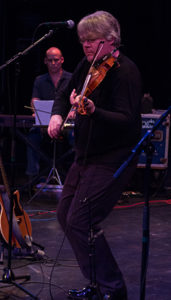
Thanks To Gravity | Andy Happel
In the 1990s the music scene in Portsmouth, New Hampshire was one of the leading contenders to be “the next Seattle.” This city of only 25,000 was home to five bands with major label interest. One of the standout acts was Thanks To Gravity, who were picked up by Capitol Records. Their most popular song was actually based on Pachelbel’s Canon in D, which even the most reluctant wedding guest will recognize. On other tracks, singer/guitarist Andy Happel often switched from guitar to electric violin for solos, which added a progressive element to their pop-rock sound.
How to Make Your Guitar Sound Like a Violin
So far we have discussed how to use guitar effects with a violin, and we’ve given you a ton of examples of how violins and strings have shaped the sound of songs and bands. How about making your guitar sound more like a violin? This could be handy if you want to play some tunes that have violin parts, but you don’t have a violin player in your band.
Let’s be clear: The only way to get the sound of a violin is to actually play violin, or get a violin player to join your band. But you can make your guitar sound a little more violin-esque, if that’s a word. You basically have two options: an EBow or effects pedals.
EBows
The EBow is a battery-powered device that you use in your picking hand instead of a pick. EBow is actually a brand name, like Kleenex and Frisbee. According to the EBow website, their very first customer was Jerry Garcia in 1976. The current model is called the PlusEBow, which sounds sort of like the word “placebo.”
EBows aren’t cheap, sadly. They’ll run you close to $100, which is pretty expensive for a little plastic gadget that looks like a stapler. You can do so much with it once you get the hang of it, though! If you’ve never used an EBow before, check out some YouTube videos to help you get started.
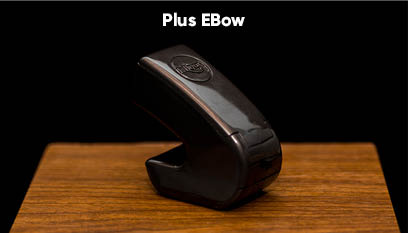
Effects Pedals
The most common type of pedal used for this purpose is the volume pedal, because it mimics the gentle attack that you’d get with an actual violin.
Some guitarists love the violin-like swells of the Boss Slow Gear SG-1 pedal. If you want one, though, you’ll have to fork over around $400 on eBay because this pedal was discontinued in the 80s. Much cheaper clones are available from companies like Mooer.
In Conclusion
If you play the fiddle, I hope you found Connor Vance’s insanely skillful playing and epic pedal board inspiring. If you play the guitar, I hope you have fun experimenting with effects to make your guitar sound more fiddle-like. Either way, definitely check out some of the other bands mentioned above — they have great violin/ guitar crossover appeal!

